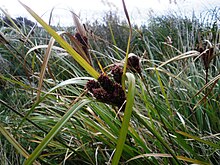
Agathis, commonly known as kauri or dammara, is a genus of evergreen coniferous trees, native to Australasia and Southeast Asia. It is one of three extant genera in the family Araucariaceae, alongside Wollemia and Araucaria. Its leaves are much broader than most conifers. Kauri gum is commercially harvested from New Zealand kauri.

Cyperus is a large genus of about 700 species of sedges, distributed throughout all continents in both tropical and temperate regions.

Ficinia spiralis is a coastal sedge endemic to New Zealand. Originally widespread, it has suffered severely from competition with introduced marram grass and animal grazing and now has only a patchy distribution.
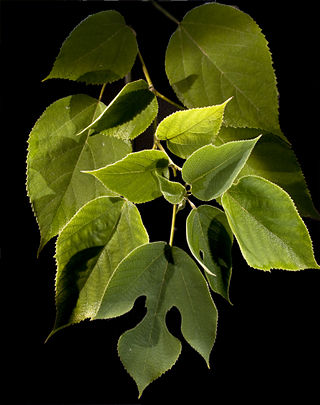
The paper mulberry is a species of flowering plant in the family Moraceae. It is native to Asia, where its range includes Taiwan, mainland China, Japan, Korea, Southeast Asia, Myanmar, and India. It is widely cultivated elsewhere and it grows as an introduced species in New Zealand, parts of Europe, the United States, and Africa. Other common names include tapa cloth tree.

Cyperus polystachyos, also known as Pycreus polystachyos, and also called manyspike flatsedge in the US, or bunchy sedge, coast flatsedge, many-spiked sedge or Texas sedge in Australia, is a herbaceous species in the family Cyperaceae, widespread in tropical and subtropical areas around the world, sometimes extending its range into temperate regions.

Māori traditional textiles are the indigenous textiles of the Māori people of New Zealand. The organisation Te Roopu Raranga Whatu o Aotearoa, the national Māori weavers' collective, aims to preserve and foster the skills of making and using these materials.

Ficinia nodosa, the knotted club-rush or knobby club-rush, is a rhizomatous perennial in the family Cyperaceae, native to South Africa, Australia, and New Zealand. Widespread in the Southern Hemisphere, Ficinia nodosa grows to between 15 and 220 cm in height. Although it grows best in sandy, salty soil, the plant grows in a wide variety of environments from coastal sand dunes to alpine regions. F. nodosa’s appearance is characterised by dense clusters of long green stems topped with small, rounded flowers often remaining throughout the year.

Cyperus laevigatus is a species of sedge known by the common name smooth flatsedge.
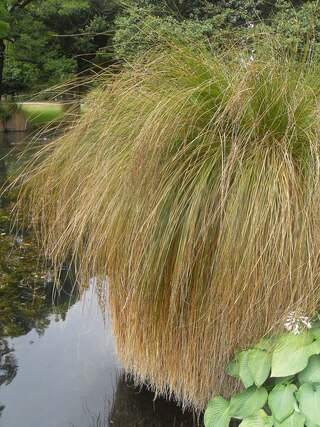
Carex secta is a sedge from the Cyperaceae family that is endemic to New Zealand. It grows in wetlands. Its Māori names include purei, pukio and makura.

Cyperus pennatiformis is a rare species of sedge known by the common name coastal flatsedge. It is endemic to Hawaii, where it grows on the islands of Maui, Kauai, and Laysan. It is a federally listed endangered species of the United States.

Austroderia is a genus of five species of tall grasses native to New Zealand, commonly known as toetoe. The species are A. toetoe, A. fulvida, A. splendens, A. richardii and A. turbaria. They were recently reclassified in 2011 from the genus Cortaderia, although their distinctiveness had been recognized as early as 1853.
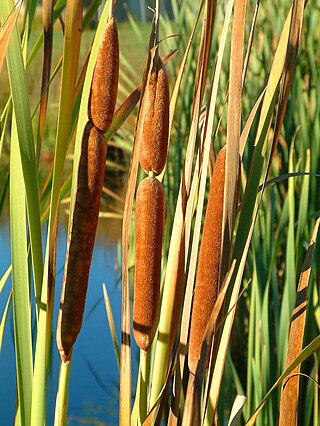
Typha orientalis, commonly known as bulrush, cumbungi, or raupō, is a perennial herbaceous plant in the genus Typha. It is native to Australia, New Zealand, Malaysia, Indonesia, Japan, Korea, Mongolia, Myanmar, Philippines, China and the Russian Far East.

Austroderia richardii, syn. Cortaderia richardii, is a species of flowering plant in the family Poaceae. It is an evergreen perennial grass. The genus Austroderia is often confused with "pampas grass", which usually refers to Cortaderia selloana. "Early pampas-grass" is a more specific name. The name "tussock grass" may also be found. The Maori name is "toetoe". It is one of five species commonly called toetoe in the genus Austroderia that are endemic to New Zealand. It occurs in the South Island and possibly also in the North Island. It is also an introduced species in Tasmania, Australia.

Hoheria glabrata, the mountain lacebark or ribbonwood, is a species of flowering plant in the family Malvaceae, endemic to New Zealand. It is one of the few deciduous trees to be found in N.Z. growing to 10 m (33 ft) tall with green leaves that turn yellow in autumn, and white flowers that appear around January.

Hoheria populnea, commonly known as New Zealand mallow, lacebark or houhere, is a species of flowering plant in the family Malvaceae, endemic to New Zealand.
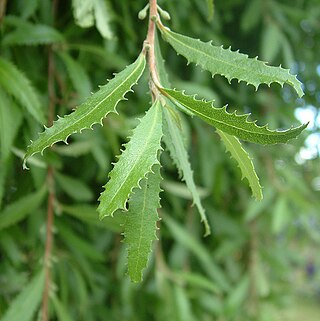
Hoheria angustifolia, the narrow-leaved lacebark or narrow-leaved houhere, is a species of flowering plant in the family Malvaceae, endemic to New Zealand. It is an evergreen tree or shrub with a weeping habit and grows to 10 m (33 ft) tall. Known as Houhere or Houhi in Māori, the bark of the tree was occasionally used for traditional textiles, similar to the traditional use of Hoheria populnea.
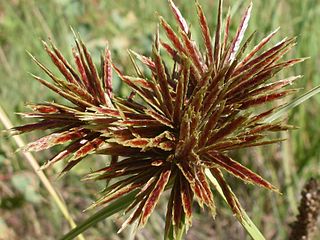
Cyperus congestus, commonly known as dense flat-sedge or clustered flat-sedge, is a sedge of the family Cyperaceae that is native to southern Africa mostly in South Africa, Lesotho and Namibia.

Hoheria lyallii, the mountain lacebark, is a species of flowering plant in the mallow family Malvaceae, native to New Zealand, where it grows on drier mountainous areas of South Island - mainly in eastern Canterbury and Marlborough. Growing to 7 m (23 ft), it is a deciduous shrub or small tree with hairy leaves and slightly scented white flowers in summer. The Latin specific epithet lyallii honours the Scottish naturalist and explorer David Lyall (1817-1895). In cultivation in the UK this plant has gained the Royal Horticultural Society’s Award of Garden Merit. Hoheria lyallii and Hoheria glabrata are known in Māori as houi, and were likely used as textiles by South Island Māori.
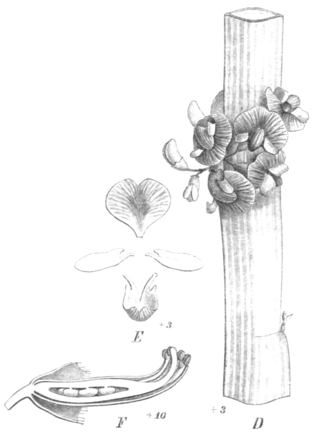
Carmichaelia australis, commonly known as the New Zealand common broom or mākaka, is a shrub of the Fabaceae family. It is native to New Zealand and found in both the North and South Islands.
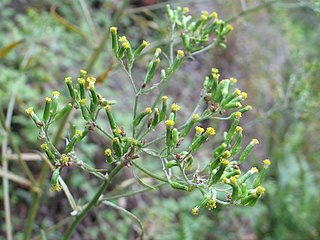
Senecio minimus, commonly known as toothed fireweed and coastal burnweed, is a species of plant in the sunflower family. It is native to Australia and New Zealand, and also naturalized on the Pacific Coast of the United States.
